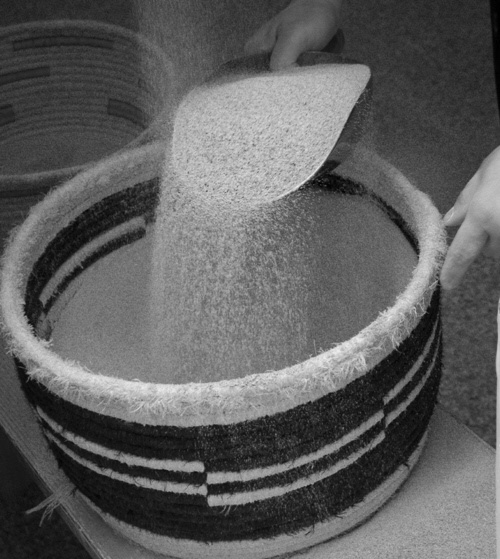We met Roberto Atzeni in the centre of Villaurbana, a small village in the region of Campidano in the province of Oristano. After having presented ourselves, we went to the flour mill managed by his brother Maurizio and his wife, the only stone mill in active use in the province of Oristano.
In the room where grain was being milled, the air was filled with a pleasant aroma of semolina, just milled, while the mill stones and the gears of the mill emitted a characteristic mechanical sound, stimulating our imaginations and reminding us of times past.
This flour mill is about 100 years old, while the remaining parts doing the milling have been restored. The mill was bought by an uncle of the father of Roberto owning it for about 40 years, but there are some traces which imply that the mill was started by the great-grandfather of Roberto in the 1800s.
Upon request, Roberto described how the flour mill works in general terms: before milling the grain, the humidity of the grain is measured and if too high, the grain has to be dried, followed by a thorough cleaning and sieving in order to get rid of impurities before the grain is ready to be milled. First, the grain is lifted by a bucket elevator and when the grain reaches the top, it falls down slowly through a slightly sloping tube into a container placed above a hole in the top millstone, which is rotating, while the lower one is stationary. The milled grain is sieved such that the semolina, which is derived from durum wheat and looking like yellow flour, is separated from the bran and collected in bags. Alternatively, the semolina may be milled again in order to obtain whatever granularity the miller wants before being put in bags.
As shown in this drawing, the bran forms the surface of the grains and is, in general, used for animal fodder, while semolina, which is the endosperm of durum wheat, is mainly used for making brown bread and pasta, but also for typical sweets of Sardinia. Instead, white flour, derived from wheat, is used for making white bread, pizza, etc. This flour mill also produces semolina which has been milled twice, mainly used for bread-making, but it is also possible to mix it with white flour from which a yellowish bread, which has lots of taste and can be stored for several days, is made.
Being a very small stone mill, the grain is milled slowly such that the grains are not subjected to excess heat,thus maintaining the nutritional characteristics of the grain and resulting in a flour which is nutritious, tasty and having a nice aroma.
Modern flour mills use metal rollers, which are computer-controlled such that the final product is a flour whose content of enzymes, proteins, fats and various other nutrients always vary within a certain range. Instead, this flour mill is controlled manually leading to that the flour will vary with from which field the grain was grown and the baked goods will leaven different amounts. It is also well-known that dough made from stone-ground flour requires a longer leavening time than dough derived from a modern flour mill.

